
© Todd Rosenberg. (Click image for larger version)
Fall for Dance at the Delacorte Theatre
Hubbard Street Dance Chicago: Gnawa
New York City Ballet: Herman Schmerman Pas de Deux
Bill T. Jones: D-Man in the Waters (Part I)
Damian Woetzel: Bend in the Road: New Orleans
New York, Delacorte Theatre in Central Park
14 September 2014
www.nycitycenter.org/Home/On-Stage/Fall-for-Dance
www.centralpark.com/guide/attractions/delacorte-theatre.html
www.publictheater.org
Ye Mists and Exhalations that Now Rise
For the second year in a row, the Fall for Dance Festival began with a pair of performances at the outdoor Delacorte Theatre in Central Park, one of the most enchanting spots in the city. (The second performance, scheduled for Sept. 13, was rained out, and had to be moved to Sunday. Such are the perils of performing in the open air.) This time of year, dusk makes its presence felt long before showtime, adding an air of mystery to the proceedings. As the audience takes its seats, mist rises from a nearby lake. The trees, artfully illuminated, loom against the inky sky. The air is crisp. I half expected a faun or a wood-nymph to bound across the stage.
It’s a magical way to start the season. Doubly so if the programming is right. But – and this is always the challenge at a festival that celebrates eclecticism – one can’t please all the people all the time. The evening’s programmers made a valiant attempt, combining the robust folk accent of Nacho Duato’s Gnawa (one of the Spanish choreographer’s most pleasing pieces) with the arch coolness of William Forsythe’s Herman Schmerman Pas de Deux, Bill T. Jones’s heroic D-Man in the Waters (Part I), and a playful mishmash of New Orleans jazz, Memphis jookin’ and ballet by Damian Woetzel, Bend in the Road: New Orleans.
Each piece had its merits. The Woetzel finale, originally meant to showcase the eye-catching moves of the young jooker Lil Buck, had to be reconceived after Buck suffered an injury earlier in the week. His cousin Ron “Prime Tyme” Myles stepped in, paired with a very fine Caroline Fermin (from Gallim Dance), who at first fluttered around in the role of an enigmatic muse and later broke into some impressive footwork of her own. A gaggle of swing dancers in sneakers (from BalletX) joined in gamely, only to be outshone by the final ingredient in this varied cocktail: Tiler Peck and Robert Fairchild from New York City Ballet. Peck wore a tiny wedding veil – a reference to her recent marriage to Mr. Fairchild? – and soft ballet slippers. The sweethearts mooned and smiled as they cycled through some boilerplate ballet partnering.
Like Buck, Myles has charisma to burn and a seemingly boundless joy when he dances. He stitches together tiny bourrée-like steps and balances elegantly on the tips of his sneakers, tilts suddenly to one side on a bent ankle, slides, glides, and bounces to the beat. He looks like he’s surfing the music, making it up as he goes along. (There are actually three choreographers credited, Damian Woetzel, Lil Buck, and Matthew Neenan.) The band, led by the keyboardist Jon Batiste, played an infectious mashup of New Orleans jazz, and even joined in the dancing. There seemed to be a message about crossing genres and finding common ground, but it all turned into a bit of a jumble. It didn’t matter much. Like the moment at the end of a flamenco program when everyone does his or her own thing, it’s the spirit that matters.
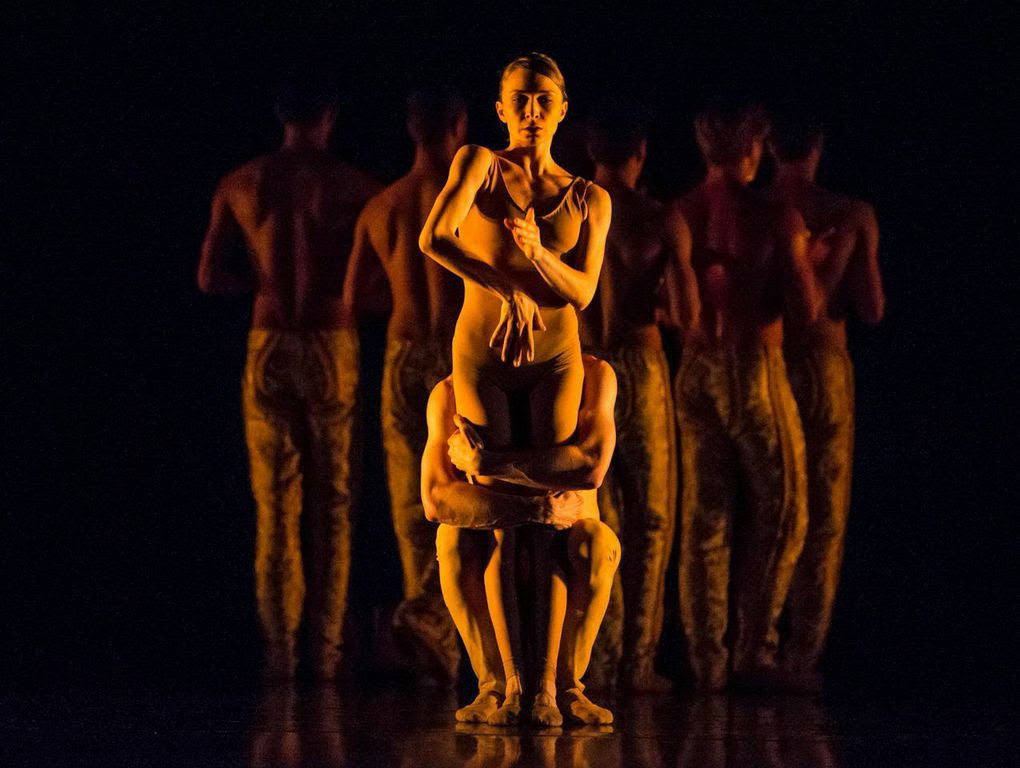
© Todd Rosenberg. (Click image for larger version)
Fortunately the other works had more structure. Each was presented by a different company. Hubbard Street Dance Chicago danced Gnawa, a suite of dances set to mesmerizing North African music in a recording by Hassan Hakmoun and Adam Rudolph. Duato creates his own folk idiom, inspired by the dances of Greece and the Balkans: line dances, circle dances, muscular duets and trios in which the men shake their legs and the women squat and clap their thighs. The men are shirtless and the women wear long black dresses. A central couple, representing a kind of primal feminine and masculine force, performs an acrobatic duet clad in skin-toned bodysuits, suggesting nakedness. In the final section, the dancers emerge from the darkness carrying tiny lights. The piece is solemn – Duato’s idea of folk dancing seems to include little joy – but it does look very handsome in this setting, and the company dances it with style and a pleasing sense of weight.
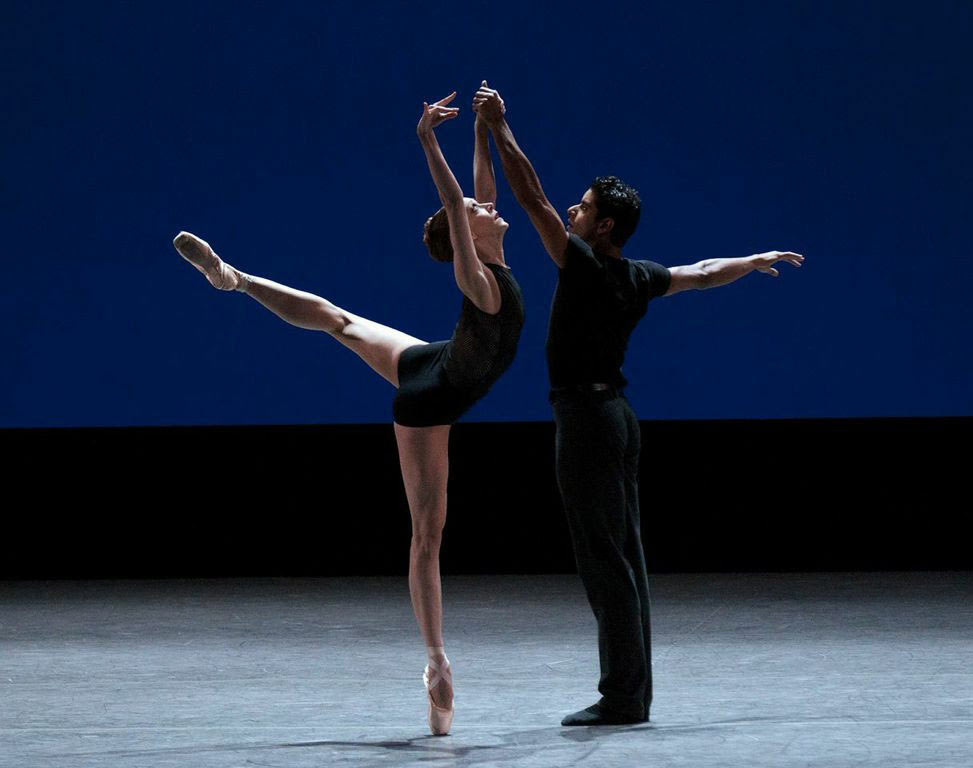
© Paul Kolnik. (Click image for larger version)
Two dancers from City Ballet, Maria Kowroski and Amar Ramasar, came next, performing William Forsythe’s Herman Schmerman Pas de Deux (1992), set to a clang-y score by Thom Willems. Like a lot of early Forsythe, the piece is showing its age. The dancers’ faux-casual stomping around and devil-may-care one-upmanship place it squarely in the period of In the Middle, Somewhat Elevated: the dancer as blasé post-Balanchinean Amazon, capable of anything, but too cool to care. Ramasar, a dancer who probably hasn’t had a blasé moment in his life – he’s more like an excitable kid – can’t quite pull off the attitude, though it’s sort of fun to watch him mug and prowl around like a toreador and do what looks very much like salsa moves. Kowroski, with legs for miles, is more of a Forsythe type, cool and dry as a martini. One thing is sure: Herman Schmerman is an artifact from another age.
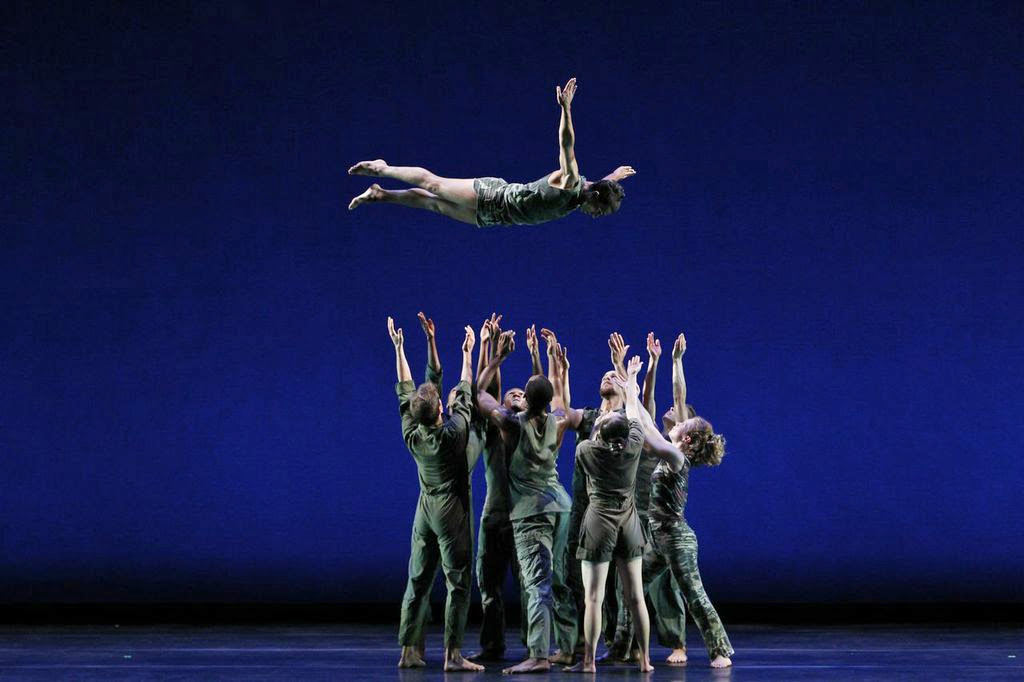
© Paul B. Goode. (Click image for larger version)
The most heart-felt, and probably the finest, piece of the evening was Bill T. Jones’s D-Man in the Waters (Part I), danced by his marvelously eclectic company. These dancers look like a cross-section of humanity, and they move that way as well. The piece, set to Mendelssohn’s propulsive Octet – played by the Orion String Quartet plus four – is an anthem, a cry of defiance against death; it was made in 1989, at the height of the AIDS epidemic, as a member of Jones’s company was dying of the disease. The dancers dive, swim against the tide, push off of each other’s backs to launch themselves into vertiginous leaps. Like Puccini’s La Boème, this is a work that celebrates friendship, the support provided by the group. The dancers, wearing camouflage – including a version that features short shorts – come to each other’s aid, just as Mimi’s friends assist her in her final moments. They catch each other when they fall, pluck flowers to brighten each other’s day, carry each other across the stage. D-Man recently entered the repertory at Alvin Ailey; the company has overlain it with a sheen of cheerfulness. It looks dangerously like a Gap ad. But Jones’s company dances it with real affection, fearlessness, and freedom. This is the way it’s supposed to look.
The rest of Fall for Dance begins Oct. 8 at City Center. You never know quite what to expect.













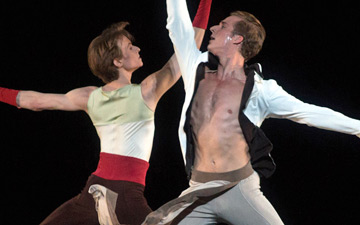
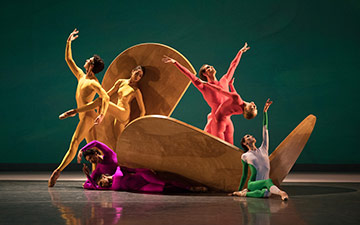


You must be logged in to post a comment.